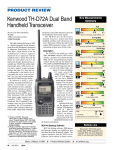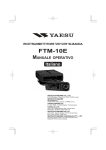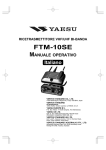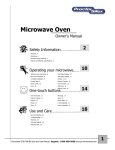Download Vertex Standard FTM-10SR Specifications
Transcript
product review Yaesu FTM-10R Dual Band Mobile Transceiver Key Measurements Summary 0.16 0.14 SINAD 0.25 0.1 Receiver Sensitivity (12 dB SINAD, µV) 96@10 MHz† , 79@10 MHz Rx 60 90 Receiver 3rd-Order Dynamic Range (dB) 62@20 kHz* , 59@20 kHz* Rx 40 70 Receiver 3rd-Order Dynamic Range (dB) 62 ChRej 50 Reviewed by Howard Robins, W1HSR ARRL Contributing Editor The FTM-10R is a rugged, weatherproof addition to the Yaesu VHF/UHF mobile product line. According to the ads, it’s aimed at outdoor motorsports enthusiasts. The waterproof control head can be separated from the main radio unit and is shown mounted on motorcycle handlebars (see sidebar). The main unit, which is not waterproof, could be stored in a saddle bag or mounted under a seat. The radio has many features, including some that distinguish it from the pack. For starters, it has a built-in AM and FM broadcast band receiver, wideband receiver coverage, weather band with alert, and 500 memory channels. Transmitter power is 50/20/5 W on 2 meters and 40/20/5 W on 70 cm. (The FTM-10SR is similar, but with 10 W on 2 meters and 7 W on 70 cm.) There’s a microphone built into the control panel, and it can be PTT or VOX activated. The FTM-10R is the first mobile radio I’m aware of that can work with Bluetooth wireless headsets. There’s also an intercom feature that lets two Bluetooth headset users talk to each other. I will get into detail about many of the special features later in this review. Good Things Come in Small Packages The radio body is compact, measuring about 1.5 × 4.25 × 5.5 inches (height, width, depth), and the detachable control panel is just over 1 inch deep. The body serves as a massive cast aluminum heat sink, so there is no cooling fan. The FTM-10R comes with hardware to support several mounting arrangements and a 3-meter-long separation cable. (An optional 20 foot separation cable is available for those bigger vehicles.) The control panel has a built-in mic, so a traditional hand mic is not necessary and not included with the radio. Yaesu offers two optional hand mics, one with a 16-key DTMF (dual-tone, multi-frequency) keypad, and one without. You can connect the microphone to the rear panel of the main unit or to the control panel with an optional adapter that connects to the bottom edge. (Note that the FTM-10R uses a special microphone connector, so you’ll need one of the optional Yaesu mics or adapters if you don’t want to use the built-in microphone.) The front of the control panel is fairly simple, with four push buttons, one twistknob and a brilliant, easy-to-read blue LCD. There are five additional push buttons on top. All push buttons are back-lit for easy visibility in the dark and are large and wellspaced for easier access by gloved fingers. I will get into how these buttons are used later in this review. The radio body has an RJ-45 jack on the front for connection to the control panel. The rear panel has an SO-239 RF connector, Mark J. Wilson, K1RO From May 2008 QST © ARRL Product Review Editor 59 Adjacent Channel Rejection (dB) 90 97 105 IF 60 135 IF Rejection (dB) 136*† Img 60 70 120 Image Rejection (dB) Snd 1 Audio Output (mW) 4.2† 4 pr031 2M Key: † Off Scale * Measurement noise limited at 70 cm value shown. Bottom Line Weatherproof, compact and rugged, Yaesu’s FTM-10R offers a number of features for motorcyclists and other nontraditional mobile operators. With VOX and Bluetooth capability, it brings hands-free mobile operation to the amateur marketplace. [email protected] external speaker jack, mic connector and dc power cord. There’s also a LINE IN jack for an external audio source, such as an MP3 player. There is an internal speaker in the radio body, and another in the control panel. Table 1 Yaesu FTM-10R, serial number 7G030319 Manufacturer’s Specifications Measured in the ARRL Lab Frequency coverage: Receive, 0.5-1.8, 76-222, 300-999 MHz (cell blocked); transmit, 144-148, 430-450 MHz. Receive and transmit, as specified. The FTM-10R comes with the control panel attached to the main unit and can be operated this way if you like. There’s a mounting frame between the control head and main unit, and out of the box it’s set up so that the two units are parallel. Yaesu supplies an angled mounting frame that tilts the control head up or down. This might improve viewing the display and operating the controls in some installations. I decided to separate the control head and main unit. To do that, I had to remove four little screws and unplug the short connecting cable. The mounting frame (one screw) and the rear panel cover (four more screws) were removed to attach the longer separation cable and install the BU-1 Bluetooth adapter to the control panel. Doing this reminded me of changing a battery in a waterproof watch — there is an O-ring gasket around the inside of the rear panel cover. The interface cable is physically locked into place inside the rear cover with a “binding plate” that slides into grooves that are cut into a waterproof grommet molded onto the cable. Once physically secured to the rear panel cover, the cable end is pushed onto pins on the panel’s printed circuit board. I am sure this complex assembly arrangement is necessary to preserve the water-tightness of the control panel. The Bluetooth unit is also pushed onto a PC board connector. You can mount the control head with a supplied hanger bracket or magnetic mount. Yaesu also offers an optional multi-angle bracket and the motorcycle handlebar bracket mentioned earlier. Power requirement: Receive, 0.5 A; transmit, 8.5 A (max); 11.7-15.8 V dc. Receive, 0.49 A; transmit, 7.2 A at 13.8 V; normal operation at 11.7 V. Modes of operation: FM. FM, AM (receive only). Receiver AM sensitivity: 10 dB S/N, 0.5-1.7 MHz, 5 µV; 108-137, 300-336 MHz, 0.8 µV. Receiver Dynamic Testing AM, 10 dB S+N/N: 1.0 MHz, 1.5 µV; 120 MHz, 0.2 µV. FM sensitivity, 12 dB SINAD: 137-150, 420- 470 MHz, 0.2 µV; 150-174, 336-420 MHz, 0.25 µV; 800-900 MHz, 0.4 µV; 900-999 MHz, 0.8 µV; WFM, 76-108 MHz, 2 µV; 174-222 MHz, 1 µV; 470-800 MHz, 5 µV. For 12 dB SINAD, 144 MHz, 0.16 µV; 440 MHz, 0.14 µV; WFM, 100 MHz, 1.1 µV FM two-tone, third-order IMD dynamic range: Not specified. 20 kHz offset: 146 MHz, 62 dB*; 440 MHz, 59 dB*; 10 MHz offset: 146 MHz, 96 dB; 440 MHz, 79 dB. FM two-tone, second-order IMD dynamic range: Not specified. 87 dB. FM adjacent channel rejection: Not specified. 20 kHz offset: 146 MHz, 62 dB; 440 MHz, 59 dB. S-meter sensitivity: Not specified. Max indication: 146 MHz, 8.4 µV; 440 MHz, 8.0 µV. Squelch sensitivity: 0.16 µV. At threshold: 146, 440 MHz, 0.13 µV. Menus and Controls *Measurement was noise limited at the value indicated. **Volume control is stepped; this is the closest step to 10% THD. Setting it Up One of the buttons on the top of the control panel is the PTT button. The control panel is small enough that you can handle it like a microphone or a handheld radio. The supplied hanger bracket or magnetic mount lend themselves to this method of operation. On-air testing demonstrated that the default mic gain setting was a bit too hot, and when dialed back a bit, provided perfect audio. For the most part, the FTM-10R menu programming is straightforward. Pressing the VOL/SEL key for 1 second gives access to 49 functions that are selected by turning the DIAL knob. Another button is used to activate or deactivate the selected function. So, 49 functions are adjustable using the same three buttons in the same way. In traditional Yaesu fashion the menu items are numbered, but also in alphabetical order, which makes scrolling through them to find what you are Receiver audio output: 4 W at 10% THD into 4 Ω. 4.2 W at 13% THD into 4 Ω.** Spurious and image rejection: Not specified. First IF rejection, 146 MHz, 97 dB; 440 MHz, 105 dB. Image rejection, 146 MHz, 136 dB*; 440 MHz, 70 dB. Transmitter Transmitter Dynamic Testing Power output (H/M/L): VHF, 50/20/5 W; UHF, 40/20/5 W. 146 MHz, 51/19/4.2 W; 440 MHz, 39/19/4.9 W. Spurious-signal and harmonic suppression: 60 dB. VHF, 65 dB; UHF, 63 dB. Meets FCC requirements. Size (height, width, depth): 1.5 × 4.4 × 7 inches; weight, 2.9 pounds. Price: $360; BH-1 headset, $90; BU-1 Bluetooth adapter, $75; CAB-1 charger sleeve, $10; MH-68B6J hand mic, $40; CT-M11 headset cable, $24. Note: Unless otherwise noted, all dynamic range measurements are taken at the ARRL Lab standard spacing of 20 kHz. looking for somewhat intuitive. In addition, buttons on top of the control head are used for what is called the “Smart Menu.” There are UP/DWN buttons that scroll through functions such as squelch level and transmit power level that are used more routinely. A third button, labeled F, changes the setting of the selected function. There is also a “Memory Set Mode” with 13 memory channel items that can be manipulated. This is where you can set the transmit power level for each channel, add alphanumeric tags, reassign channel numbers, and so forth. The clock also has its own set mode with six adjustable parameters. It also functions as a timer or stopwatch. Bluetooth and VOX Operation In recent years a lot of attention has been paid to developing tools for “hands free” cell phone operation. With the inclusion of VOX and Bluetooth features, operating the FTM-10R can be hands-free too. We ordered and installed the optional BU-1 Bluetooth adapter, the BH-1 Bluetooth headset and the CAB-1 charger sleeve (to charge the battery in the BH-1 headset). After installing the adapter and charger sleeve, the radio must be “paired” with the headset so that they recognize and communicate with each other. I found that the pairing instructions were incorrect in the printed manual that came with this radio. (You must power up From May 2008 QST © ARRL Motorcycle Mobile with the FTM-10R Hams have been installing mobile radios on motorcycles for years, but the FTM-10R is the first one we’ve seen that’s specifically designed to be bikefriendly. To find out more, we checked out the installations of Adam Koczarski, KA7ARK, of Bellevue, Washington, and Allan Buckshon, VE7SZ, of Langley, British Columbia. Adam and Allan both ride Honda ST1300 sport-touring bikes. The ST1300 has luggage carrying capability and is comfortable for long-distance touring, yet is suitable for spirited riding on twisty back roads. Allan picked up a pair of FTM-10Rs at Dayton last year, and he Figure 1 — The FTM-10R main unit is small enough to fit under the ST1300’s seat. Figure 2 — The FTM-10R control head mounts on the left handlebar of Adam’s bike, sharing the cockpit with a GPS receiver and other accessories to make long-distance travel more enjoyable. the radio while pressing the VOL/SEL button in order to get into the mode required for pairing.) I downloaded an updated manual from Yaesu’s Web site, and with the new instructions everything worked as expected. In addition to the BH-1, I tested two commercially available cell phone Bluetooth devices with great success. Bluetooth devices come with codes that need to be programmed into the radio in order for the pairing to work. My cell phone devices had codes different From May 2008 QST © ARRL and Adam installed them for the summer 2007 riding season. Adam installed his transceiver body under the seat (Figure 1). Along with other electronic accessories, it’s powered from an auxiliary fuse panel and noise filter. The control head is on a swivel mount on the handlebar (Figure 2). The antenna, a Comet CA-2x4SR dual-bander, mounts on a bracket attached to a luggage rack at the back of the bike. Inside his full-face helmet, Adam uses an Autocom headset. The Autocom communications system is a popular accessory for riders equipping their bikes with cell phones, MP3 ADAM KOCZARSKI, KA7ARK players, GPS receivers, FRS transceivers or other audio/ communications equipment. The only real difficulty encountered during installation was connecting the FTM-10R to the Autocom control box. At the time of installation, no connector, cable or information about the FTM-10R’s mic jack was available. Removing the element from an optional hand mic allowed a makeshift connection using the radio’s VOX feature. Yaesu has since introduced the CT-M11 accessory cable and an information sheet for connecting the transceiver to external headsets. Before next season, Adam and Allan plan to rewire their bikes using the CT-M11 cable and to hook up PTT through the Autocom system. How does it work? “Fine,” says Adam, KA7ARK. “The ability to listen to FM or my MP3 player and have the ham band audio cut in when receiving a signal is nice. There’s plenty of audio. The split system with the lightweight head on the bars is nice.” “The radio works well on 2 m and 440, and the FM band stereo receiver is good,” adds Allan, VE7SZ. “I have not used PTT, but I found the VOX to be excellent using the headset. It took a bit of adjusting, but I get great VOX response and few false trips at spirited motorcycle speeds. When I change to the CT-M11 cable I’ll look forward to adding PTT to have the ability to select either way. The control head has been weatherproof as advertised, and the controls can be ADAM KOCZARSKI, KA7ARK adjusted with gloves. That was the reason I purchased the radio, and I am happy with it.” For more photos, see Adam’s Web site at koczarski.com/ Motorcycles. Other motorcycle mobile resources include Chapter 4 in ARRL’s book Amateur Radio on the Move (order no. 9540; see your local dealer or www.arrl.org/shop) and the Motorcycling Amateur Radio Club (www.marc-hq.org). — Mark Wilson, K1RO, Product Review Editor from each other and from the BH-1. So, you need to consult the instructions that come with devices for their respective codes and how to get them into pairing mode. The FTM10R defaults to the code for the BH-1. The FTM-10R can be programmed to allow Bluetooth devices to work with VOX or with a PTT switch on the Bluetooth device. If you do not use VOX, you must push the PTT button on the BH-1 headset to transmit. I found this uncomfortable because pressing the PTT switch also presses the earphone into your ear. That can be improved with a menu setting that changes the PTT mode so that you don’t have to hold the PTT button (press it once to transmit, and again to return to receive). The manual describes this function in the context of the PA feature, but it also applies to transmitting with Bluetooth or control panel mic. I do not usually use VOX. It does work, but for me it took some getting used to. There are three VOX sensitivity settings available. VOX seemed to work well with the cell phone devices too. With VOX you need to be careful about your verbal reaction to the usual travel annoyances, such as an idiot cutting into your lane on the highway. Other Features AF Dual. With this feature turned on, you can monitor any covered amateur frequency while listening to the built-in AM/FM broadcast radio or an external MP3 player connected to LINE IN. You can also choose to listen to a programmed “Club Channel” (see below) while monitoring another amateur frequency. When signals appear on the amateur frequency, the radio automatically switches to it. While in AF Dual mode, the display flashes between the two frequencies being monitored. This feature probably would be better called “RF Dual,” since it monitors two radio frequencies while you listen to the audio of one at a time. Club Channel. This is an enhanced call channel that can be programmed to any frequency in the 2 meter or 70 cm bands. When Club Channel Monitor is activated, the preset club frequency is “watched” every 3 seconds. You can listen to broadcast radio, an external audio device or another amateur frequency while keeping an eye on the club channel. You can set an option to remain on the club channel after a signal is received there, or to go back to watch mode. Paging. The Enhanced Paging and Coded Squelch (EPCS) feature uses two stored CTCSS tones to open the receiver squelch, and encodes two other tones that are sent when you key the transmitter. When activated, a ringing bell sounds when the tones are received and the squelch is opened. EPCS is intended to keep the receiver quiet unless you’re called by someone transmitting the correct tones, presumably a friend or fellow club member. Each receiver in your group could be programmed with its own unique set of squelch tones, but doing so would require you to maintain a list and manually select those tones each time you paged an individual. From a practical standpoint EPCS might better be viewed as a group alerting/ calling system in which all members use the same tones. Note that if you are using a frequency that is shared with other users who are not part of your group, you could inadvertently interfere with them when you transmit. If the other users are not using your ECPS tones, their signals won’t open your squelch and you won’t know they are using the frequency. Messaging. This feature allows you to program and send text messages of up to 16 characters to a group of up to 20 members. The received message scrolls across the display on the receiving end. All members must be using the same club frequency and have the same group member list (IDs could be names or call signs). Up to 20 messages can be stored, and the same preprogrammed messages must be in the same slots in all of the group member radios. Messages are not sent through a repeater, and messaging cannot be activated when CTCSS, DCS or Pager are activated. Wireless Cloning. The FTM-10R can transfer settings and data to other FTM-10Rs so that they are all set up the same. This feature uses the Club Channel, which must be set in the 70 cm band for this function Weather band/weather alert. The FTM-10R is factory programmed with the 10 NOAA weather channels. The severe weather alert monitors for NOAA’s 1050 Hz tone alert. After turning this feature on, there is no indication of it on the LCD. Intercom. With Bluetooth enabled, riders and passengers can communicate with each other using Bluetooth headsets. This can be useful while wearing helmets or while in environments with high levels of ambient noise. Public Address. Attach an external speaker and select PA from the Smart Menu and you have an 8 W public address system. While in this mode, the PTT opens the mic but does not key the transmitter. WiRES. Yaesu’s Wide-Coverage Internet Repeater Enhancement System is supported in the Sister Radio Group (SRG) and Friends’ Radio Group (FRG) modes. ARTS. This feature uses DCS (digital coded squelch) signaling to alert users when they are within simplex range of each other. When activated, a subaudible DCS code is transmitted for one second every 25 seconds, or whenever the PTT is pushed. If another radio with this feature activated is within range, an audible beeper sounds (if enabled) and the LCD reads IN.RANGE . Polling signals continue until the ARTS feature is deactivated. Three beeps sound if you go out of range for more than one minute and OUT. RANGE is displayed. I had only one FTM10R to test for this review, so was unable to actually test the unique features that require two or more radios — paging, messaging, cloning and ARTS. Final Thoughts The User Manual was obviously written in another language and translated into English. I found some of the instructions confusing and needed to contact Yaesu for help. Customer service was responsive and helped me through my questions. Some errors we found have been corrected in the downloadable manual available from the Yaesu Web site. A newer version is said to be provided with new radios. There is no programming software or computer interface available or planned. Once I got used to the procedures, manipulating features was fairly easy. With 500 memory channels and so many special features, I think that programming software would help with keeping track of stored parameters and make updating more efficient to implement. It is clear that Yaesu had motorcycles, boats, recreational vehicles and other nontraditional mobile installations in mind when they developed this rig. The receive audio is powerful enough to be useful in noisy environments. The addition of Bluetooth and hands-free operation is something that I think we will be seeing more of in mobile radios. Use of VOX on repeaters is questionable in my opinion, but for on-the-road simplex operation, along with Bluetooth headsets, it should be a welcomed capability. M a n u f a c t u re r : Ve r t ex S t a n d a r d , 10900 Walker St, Cypress, CA 90630; tel 714-827-7600; www.yaesu.com. SteppIR 40-30 Meter Upgrade Kit Reviewed by H. Ward Silver, NØAX QST Contributing Editor In February 2003, I had the opportunity to review one of the just-introduced three element SteppIR Yagi antennas.1 For those of you who 1H.W. Silver, NØAX, “SteppIR Three Element Yagi Antenna,” Product Review, QST, May 2003, pp 67-69. Bottom Line SteppIR’s upgraded driven element provides rotatable dipole performance on 40 and 30 meters without compromising 20-10 meter performance. aren’t familiar with the SteppIR technology, the elements of this Yagi are adjustable in length. A special beryllium-bronze perforated tape is extended and retracted inside hollow fiberglass tubes by stepper motors (thus the name). There’s also an optional fixed element (a director) near the center that’s used for 6 meter operation only. In the shack, a microprocessor in the From May 2008 QST © ARRL













